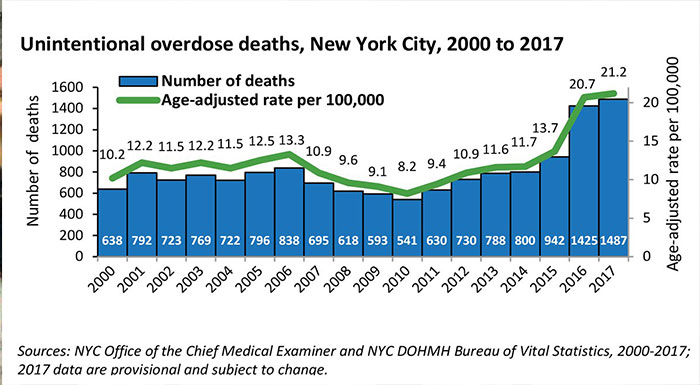Courtesy of City Department of Health and Mental Hygiene
By Michael V. Cusenza
Drug overdose deaths in the five boroughs remained at epidemic levels in 2017, but the rate of increase slowed down significantly last year—with a 2-percent overall increase, compared to the 51-percent uptick recorded for 2016, according to an analysis published on Monday by the City Department of Health and Mental Hygiene.
The City’s Epi Data Brief confirmed 1,487 drug overdose deaths in 2017; that’s 62 more deaths than the prior year. In contrast, in 2016 there were 437 more deaths than 2015.
And for the first time, fentanyl was the most common substance involved in city drug overdose deaths, according to the report. The lethally potent synthetic opioid was detected in more than half (57 percent) of all overdose deaths, up from 44 percent in 2016.
The 2017 Epi Data Brief also noted another first: For the first time in 11 years, black New Yorkers had the highest rate of drug overdose death, compared to whites and Latinos. Of the black New Yorkers who died from drug overdose in 2017, the largest number lived in the Bronx. Among black New Yorkers, residents of the Bronx and Manhattan had the highest rates of overdose, according to the analysis.
“New York City’s drug overdose epidemic continues, but the story of who is affected is changing,” said Acting City Health Commissioner Oxiris Barbot, M.D. “For the first time in over a decade, the risk of fatal overdose is higher in African Americans than in Whites. Still, the rate of increase has slowed, and we are optimistic that the many efforts of HealingNYC are moving us in the right direction. These include connecting more New Yorkers to medications for addiction treatment and life-saving naloxone. We are committed to using our data to target our approaches to the communities most at risk of overdose.”
Other Epi Data Brief highlights:
• In 2017, every six hours someone in the five boroughs died of an overdose, versus every seven hours in 2016.
• In 2017, residents of the Bronx had the highest rate and number of overdose deaths (363 deaths), compared to residents of the other four boroughs.
• Residents of the highest-poverty neighborhoods experienced a 25-percent increase in the rate of overdose death from 2016 to 2017. The rate of overdose death in the highest-poverty neighborhoods was more than double the rates in medium and low-poverty neighborhoods.
• In NYC, Black New Yorkers had the largest increase in the rate of opioid-involved overdose deaths for the second year in a row, a 93-percent increase in 2016 and a 28-percent increase in 2017.
• The rate of overdose death among Latino New Yorkers increased by 3 percent from 2016 to 2017.
• Opioid painkillers, excluding fentanyl, were involved in 214 overdose deaths (14 percent) in 2017; 65 fewer deaths involved an opioid analgesic in 2017 compared to 2016.
• Nearly three quarters (73 percent) of all overdose deaths involved heroin and/or fentanyl in 2017, consistent with 2016.
In other opioid-related news, the Department of Justice recently warned that if the City moves ahead with Mayor Bill de Blasio’s plan to establish four supervised narcotic injection sites it would be in violation of the federal Controlled Substances Act.
Courtesy of City Department of Health and Mental Hygiene

